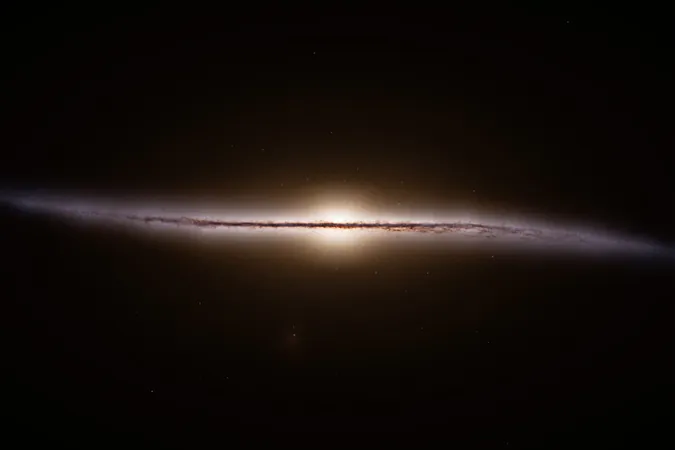
Gaia's Historic Journey: Galaxy Mapping Marvel Retires After Unprecedented Discoveries!
2025-01-15
Author: Yan
Gaia's Historic Journey
The European Space Agency’s Gaia mission has accomplished a monumental feat: creating the most detailed map of the Milky Way galaxy, drawn from a staggering three trillion observations over its decade-long mission from July 24, 2014, to October 2023. As the spacecraft approaches retirement due to dwindling fuel reserves, the wealth of knowledge it has provided has forever altered our understanding of the galaxy.
Groundbreaking Discoveries
Gaia's extensive dataset reveals insights beyond imagination. With observations covering two billion stars and various celestial objects, scientists have produced a comprehensive representation of how the Milky Way appears from various angles, including both edge-on and face-on perspectives. Intriguingly, Gaia's findings suggest that the Milky Way possesses more than just the previously acknowledged two spiral arms, indicating a more complex structure shaped by various forces.
The Galactic Bulge and Black Holes
Central to this galactic landscape is the bulging region, known as the galactic bulge, which houses Sagittarius A*, a supermassive black hole that captivates astronomers and challenges our understanding of cosmic structures. Moreover, Gaia's data led to the groundbreaking discovery of the heaviest stellar-mass black hole located just 2,000 light-years from Earth, adding another layer of intrigue to our cosmic neighborhood.
Reevaluating the Milky Way's History
But Gaia's revelations didn't stop there. Recent analyses highlighted potential late encounters between the Milky Way and other galaxies, pushing the timeline of our galaxy's evolution back by billions of years. This surprising finding has prompted a reevaluation of longstanding theories concerning the Milky Way’s formation and lifespan.
Transformative Impact
Stefan Payne-Wardenaar, a scientific visualizer at the Haus der Astronomie in Germany, emphasized Gaia’s transformative impact in a press release, stating, "Gaia has changed our impression of the Milky Way." He pointed out that even fundamental concepts—such as the rotation of the central bar and the structure of spiral arms—have undergone significant revisions thanks to Gaia’s detailed observations.
Achievements of Gaia
Among its numerous achievements, Gaia meticulously tracked the orbits of over 150,000 asteroids and crafted a three-dimensional map of more than a million quasars, marking it the most extensive map of these distant entities to date. Yet, as Payne-Wardenaar mentioned, much of the distant galaxy remains a subject of ongoing research, contingent on the continuous release of Gaia data.
Looking Forward
As the spacecraft prepares for retirement, it will transition into a designated orbit after completing a series of final technology tests. Notably, Gaia’s legacy continues, as it is set to release another significant data set in 2024, followed by further updates planned for the end of the decade. Over its lifespan, Gaia has generated an incredible 500 terabytes of data, with many more discoveries anticipated in the future, including fresh insights about exoplanets and binary star systems.
The Journey Continues
Reflecting on Gaia's journey, project scientist Johannes Sahlmann explained, "After 11 years in space, surviving micrometeorite impacts and solar storms, Gaia has finished collecting science data. Now, all eyes turn towards the preparation of the next data releases." With so much research stemming from its remarkable observational capabilities, the story of Gaia will undoubtedly continue to inspire and inform our pursuit of knowledge about our universe for years to come.
Conclusion
Stay tuned, as the mysteries of the Milky Way are far from over!




 Brasil (PT)
Brasil (PT)
 Canada (EN)
Canada (EN)
 Chile (ES)
Chile (ES)
 Česko (CS)
Česko (CS)
 대한민국 (KO)
대한민국 (KO)
 España (ES)
España (ES)
 France (FR)
France (FR)
 Hong Kong (EN)
Hong Kong (EN)
 Italia (IT)
Italia (IT)
 日本 (JA)
日本 (JA)
 Magyarország (HU)
Magyarország (HU)
 Norge (NO)
Norge (NO)
 Polska (PL)
Polska (PL)
 Schweiz (DE)
Schweiz (DE)
 Singapore (EN)
Singapore (EN)
 Sverige (SV)
Sverige (SV)
 Suomi (FI)
Suomi (FI)
 Türkiye (TR)
Türkiye (TR)
 الإمارات العربية المتحدة (AR)
الإمارات العربية المتحدة (AR)